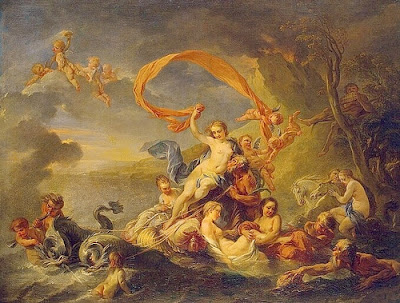The search for a painter born around this time of year, with fascinating background or life story brought little of interest. My yawns caused me to stumble down an internet rabbit-hole while skimming through the biography of 17th century French painter Jean-Baptiste van Loo (14 January 1684 – 19 December 1745).
One of van Loo's best known paintings is shown in the small image below:
"Triumph of Galatea", and...ooops! Down the rabbit-hole I fell!
A better, larger image of the work is available here.
From Mental Floss website
Alrighty then - but what about Pygmalion? That word brings forth memories of Audrey Hepburn, Julie Andrews, Rex Harrison.4. "Galatea," which means "she who is milk-white," refers to three women in mythology. Of the three, the most well-known was the wife of King Pygmalion of Cyprus. Another was a Sicilian nereid, or sea nymph, who was in love with Acis, the son of Faunus and a river nymph. The final Galatea was the wife of Lamprus; she prayed to Leto that her daughter be turned into a son.
5. Jean-Baptiste van Loo's "Triumph of Galatea" is likely a representation of the Galatea who loved Acis. According to the story, the cyclops Polyphemus was jealous of Acis and thus killed him with a boulder. Galatea was distraught over the murder of her love, and so she turned his blood into the river Acis (in Sicily). However, no sources appear to document the inspiration or source of "The Triumph of Galatea."
See Wikipedia HERE and HERE.Pygmalion, a play by George Bernard Shaw, named after a Greek mythological figure. In ancient Greek mythology, Pygmalion fell in love with one of his sculptures, which then came to life. The general idea of that myth was a popular subject for Victorian era English playwrights, including one of Shaw's influences, W. S. Gilbert, who wrote a successful play based on the story called Pygmalion and Galatea that was first presented in 1871. Shaw would also have been familiar with the burlesque version, Galatea, or Pygmalion Reversed.
Shaw's play has been adapted numerous times, most notably as the musical My Fair Lady and its film version.
Who'd've thunk it? Jean-Baptiste van Loo, via Galatea, down a rabbit-hole off-shoot, to this:


2 comments:
In the light of 2019 Pygmalion and My Fair Lady lose a lot of their former allure and actually appear quite creepy to me. In many ways with the messages they portray about women/girls always needing improvement or puppetized.
Just me.
Still fighting for women's rights.
XO
WWW
Wisewebwoman ~ I wasn't putting Pygmalion or My Fair Lady forward in that light here though, WWW - just an example of an innocent trip down an arty farty rabbit hole. :)
I'm as keen on women's equality as anybody, WWW, but such works as these really have to be appreciated with the historical atmosphere from which they came kept in mind. Otherwise much of the art and creativity from the past will gather a bad smell, which it does not fully deserve. My opinion only (we all have 'em) :)
Post a Comment